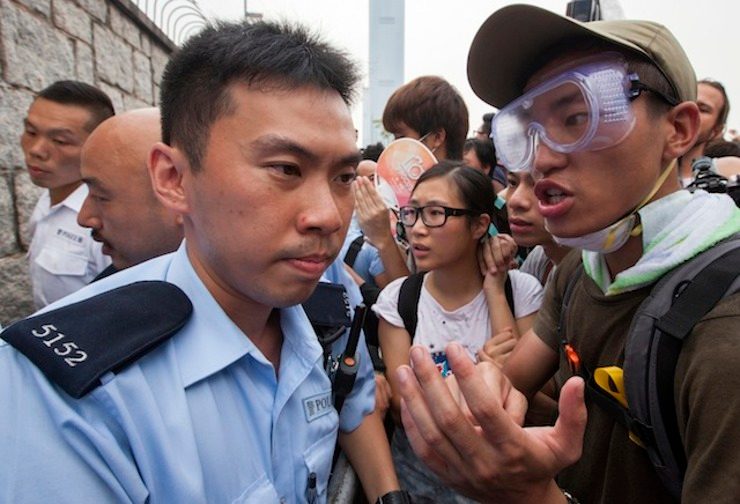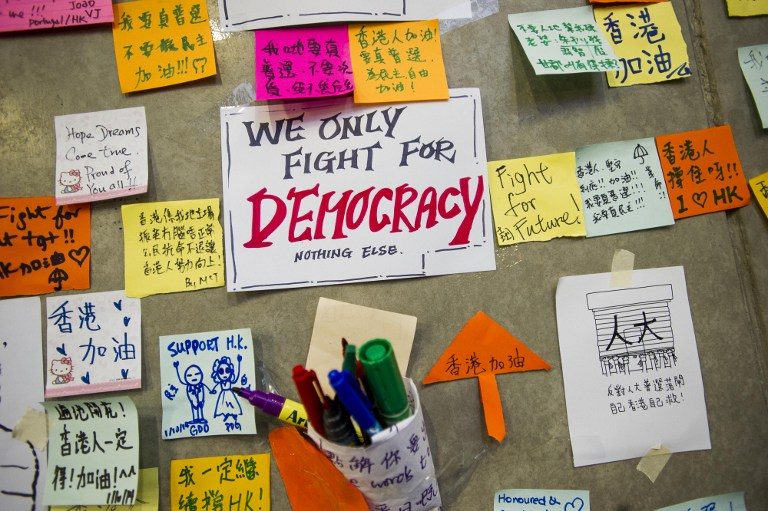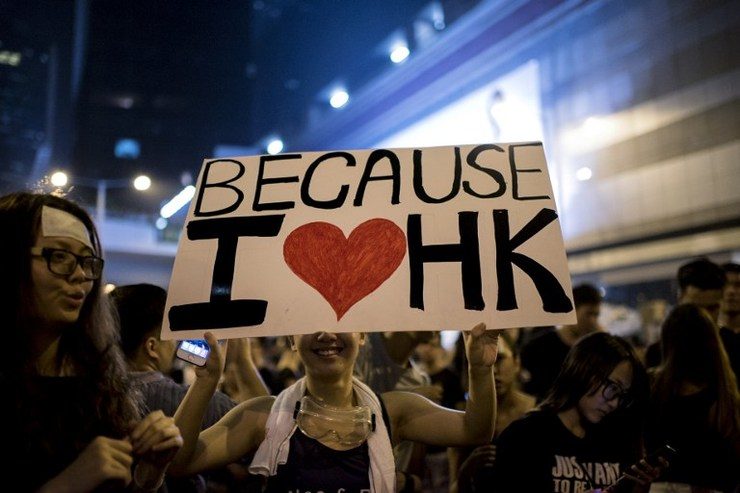SUMMARY
This is AI generated summarization, which may have errors. For context, always refer to the full article.

HONG KONG (UPDATED) – Crowds of protesters in Hong Kong swelled Thursday after police were seen unloading boxes of tear gas and rubber bullets, sending tensions soaring as authorities urged pro-democracy demonstrators to disperse “as soon as possible.”
Huge throngs have shut down central areas of the southern Chinese city with a mass sit-in, including outside the city’s legislative assembly, and have given Chief Executive Leung Chun-ying until midnight to step down or face escalated action.
China backed the city’s embattled leader, saying it was behind Leung “firmly and unshakably” and pledging support for the police as protesters prepared for a fifth night at the barricades.
Days of peaceful demonstrations have seen tens of thousands of people take over the city’s usually traffic-heavy streets as they demand Beijing grant fully free elections in the semi-autonomous city.
In August, China said Hong Kongers would be able to vote for their next leader in 2017 but only those vetted by a loyalist committee would be allowed to stand – something demonstrators have dismissed as a “fake democracy.”
The city authorities Thursday said they wanted the streets cleared around the government headquarters with with civil servants expected to return after a two-day public holiday.
In a statement, officials called on protesters “not to block the access there and to disperse peacefully as soon as possible”. School classes in the protest affected areas will also be suspended Friday, October 3, they added.
Alarm and anger
The late afternoon resupply by police officers caused widespread alarm among protesters but more demonstrators arrived on the scene regardless after an appeal from leaders.
Pictures shared widely on social media and television showed one barrel with the words “Round, 38mm rubber baton multi” written on it. Another had “1.5 in, CS” emblazoned on it, a possible reference to tear gas.
“The more people are here, the safer we are,” Heiman Chan, 25, told Agence France-Presse, adding he rushed down to the main protest site after seeing photos of the rubber bullet barrels on Facebook.
“We’re not going to leave this space for anything. If they use tear gas we’ll run back and hold a new area, if they use rubber bullets we’ll have to run a little faster,” he added.
Some of those in the crowd wanted to block one of the last trunk roads still open in the area while others were concerned it could provoke violent action from the police.
“If we occupy every road we will provoke the police, and we’ve already done that by occupying Admiralty,” Ares Tse told AFP, in reference to the area that has become the epicenter of the protests.
“The point is to start a dialogue on political reform, not fight police.”
Beijing defiant
China’s Communist Party has shown no sign of bowing to protesters’ twin demands that Leung step down by Thursday and that Beijing allow Hong Kongers to nominate their next leader.
An editorial in the Communist Party mouthpiece the People’s Daily Thursday warned against “chaos” in the city, adding Beijing supported “the police of the special territory in handling these illegal protests according to the law”.
Beijing’s latest comments came after China’s foreign minister issued a stern warning to the United States not to meddle in its “internal affairs”.
The demonstrators consider Leung a Beijing stooge and protest leaders want Thursday’s ultimatum to be met.

“We will consider having different operating actions in future days, including occupying other places like important government offices,” said Agnes Chow of student movement Scholarism.
Some analysts say it is unlikely that Leung will step down, in what would be a massive loss of face for the establishment.
“If Beijing forces him to resign, they will be seen to be buckling under pressure from the protesters. They might give out signals that he has been sidelined, but the likelihood of his immediate dismissal… is not very high,” said Willy Lam, a China scholar at the Chinese University of Hong Kong.
However Lam added that the longer the protests affect Hong Kong, the more pressure Chinese president Xi Jinping will be under to act.
In a movement being dubbed the “umbrella revolution” – a nod to the umbrellas they have used to protect themselves against pepper spray, the sun and torrential downpours alike – the protesters have brought key parts of the city to a standstill, heavily disrupting the transport network and shutting down businesses.
The protests pose a huge political challenge for Beijing at a time when the Communist Party is cracking down hard on dissent on the mainland.
Authorities have scrubbed mentions of the protests from Chinese social media, while rights groups say more than a dozen activists have been detained and as many as 60 others questioned for expressing support for the Hong Kong crowds.
In a sign of Beijing’s growing unease, a local tourism leader said Chinese travel agents were reporting that group visits to the city had been suspended.
October 1-7 is known as “Golden Week” in mainland China, a key shopping holiday that usually sees many travel to Hong Kong. – Rappler.com
Add a comment
How does this make you feel?

There are no comments yet. Add your comment to start the conversation.